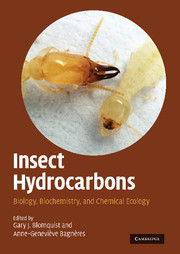Book contents
- Frontmatter
- Contents
- List of contributors
- Foreword
- Acknowledgments
- Part I Chemistry, Biochemistry, and Physiology
- 1 Introduction: history and overview of insect hydrocarbons
- 2 Structure and analysis of insect hydrocarbons
- 3 Biosynthesis of cuticular hydrocarbons
- 4 Molecular biology and genetics of hydrocarbon production
- 5 Site of synthesis, mechanism of transport and selective deposition of hydrocarbons
- 6 Cuticular lipids and water balance
- 7 Chemical taxonomy with hydrocarbons
- 8 Chemical synthesis of insect cuticular hydrocarbons
- 9 Oxygenated derivatives of hydrocarbons
- Part II Chemical Communication
- Index
6 - Cuticular lipids and water balance
from Part I - Chemistry, Biochemistry, and Physiology
Published online by Cambridge University Press: 18 May 2010
- Frontmatter
- Contents
- List of contributors
- Foreword
- Acknowledgments
- Part I Chemistry, Biochemistry, and Physiology
- 1 Introduction: history and overview of insect hydrocarbons
- 2 Structure and analysis of insect hydrocarbons
- 3 Biosynthesis of cuticular hydrocarbons
- 4 Molecular biology and genetics of hydrocarbon production
- 5 Site of synthesis, mechanism of transport and selective deposition of hydrocarbons
- 6 Cuticular lipids and water balance
- 7 Chemical taxonomy with hydrocarbons
- 8 Chemical synthesis of insect cuticular hydrocarbons
- 9 Oxygenated derivatives of hydrocarbons
- Part II Chemical Communication
- Index
Summary
Epicuticular lipids serve many roles in insects and other terrestrial arthropods (see other chapters in this volume), but the first to be recognized was as a barrier to transpiration through the surface of the animal. Surface-area to volume ratios increase as size decreases, so that smaller animals become increasingly susceptible to dehydration. Künelt (1928; cited by Wigglesworth, 1933) noted the presence of hydrophobic substances on the insect cuticle and proposed that these reduce water-loss. Their importance in water conservation is made apparent by the fact that even a brief treatment with organic solvents to remove surface lipids can result in water-loss rates increasing 10–100 fold (Hadley, 1994). On the other hand, water can be lost via other routes. These losses can be substantial (e.g. bloodsucking insects excrete huge amounts of fluid after a meal). Thus, under certain conditions, cuticular waterproofing may be a minor part of the overall water budget.
We address several issues in this chapter. First, is cuticular water-loss significant? The importance of spiracular control and discontinuous gas exchange in insect water balance has been challenged in recent years, leading to a need to reassess insect water budgets in general. Second, if cuticular transpiration is important for the overall water budget of insects, how does variation in surface lipid composition affect transpiration through the cuticle? We will discuss the relationships between lipid composition, lipid physical properties, and cuticular permeability. Third, what is the biophysical explanation for the critical temperature phenomenon, a rapid increase in water-loss at high temperatures? We consider both experimental results and a few theoretical issues that address this question.
- Type
- Chapter
- Information
- Insect HydrocarbonsBiology, Biochemistry, and Chemical Ecology, pp. 100 - 120Publisher: Cambridge University PressPrint publication year: 2010
- 93
- Cited by



